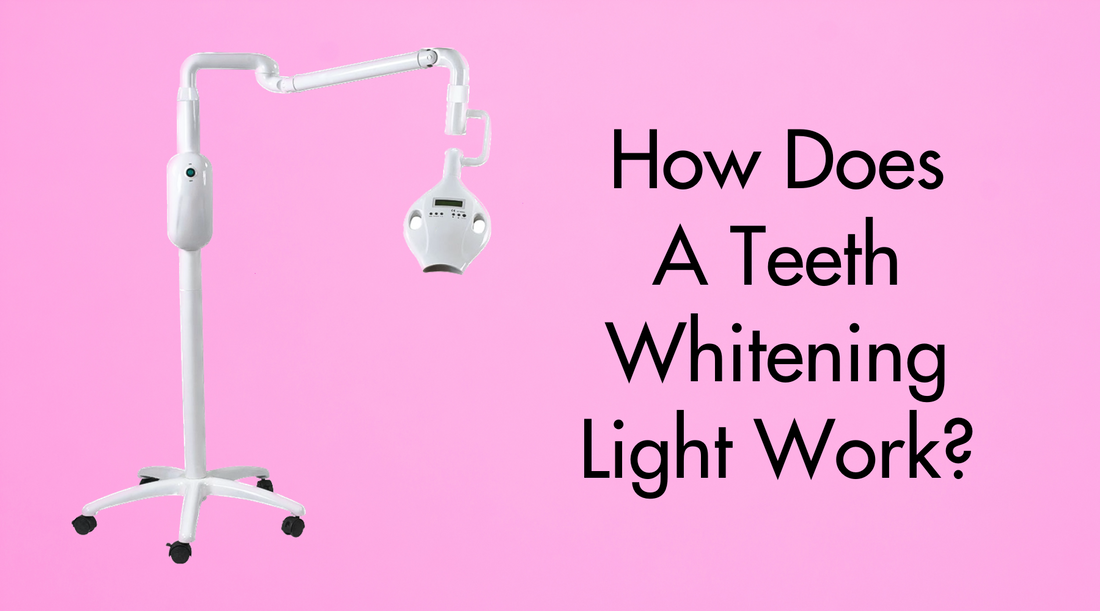
How Does A Teeth Whitening Light Work?
Share
If you're looking to provide teeth whitening services, have had your teeth whitened by a professional in the past, or whitened your teeth at home with a teeth whitening kit, you may have seen or heard of teeth whitening lights.
Over the last 20 years, these devices have become more and more popular for their ability to enhance the effectiveness of teeth whitening treatments.
Teeth whitening lights are also called teeth whitening lamps, teeth whitening machines and even sometime teeth whitening lasers (lol). While they are not a laser by any means, if you see the device called any of the above-mentioned variations, note that they are all the exact same technology.
But how do they work? What exactly does a teeth whitening light do?
In this article, we'll explore how teeth whitening lights work and how they can help your clients achieve the smile of their dreams.
The Basics of Teeth Whitening
It’s important to understand the science behind teeth staining. The natural color of teeth is not a uniform white shade. Instead, teeth can range from light yellow to grayish-white.
This color is determined by the thickness and color of the tooth enamel and the underlying dentin.
However, various factors can cause teeth to become discolored and stained over time.
Common culprits include coffee, tea, red wine, tobacco, artificially colored beverages and certain medications. These substances can penetrate the porous tooth enamel and cause discoloration.
Teeth whitening treatments work by using a bleaching agent, usually hydrogen peroxide or carbamide peroxide, to break down and remove these stains.
The active ingredients in the whitening gel penetrate the enamel and dentin and break down the chemical bonds between the stain molecules, resulting in a whiter, brighter smile.
So, Where Do Teeth Whitening Lights Come In?
Teeth whitening lamps are lighting devices that emit a special wavelength of blue light that activates the whitening gel, enhancing the effectiveness of the treatment.
The blue light helps to speed up the chemical reaction between the peroxide and the stains, making the whitening process more efficient.
The science behind teeth whitening lights is based on a process called phototherapy. This is the use of light to stimulate a biological response in the body.
In the case of teeth whitening, the blue light activates the whitening gel, making it more effective at breaking down stains.
The only difference between a professional teeth whitening light and an at-home whitening light is the intensity of the blue light. Home teeth whitening lights are less intense, eliminating the possibility of misuse and ensuring safely for the home user.
How Does Blue Light Whiten Teeth?
The light emitted by teeth whitening lights falls within a specific wavelength range of the visible light spectrum. This range, typically between 430 and 490 nanometers, is known as the blue light spectrum.
The blue light works by activating a chemical called photo-activated hydrogen peroxide. This is a type of hydrogen peroxide that is specially formulated to be activated by blue light.
When the blue light comes into contact with the photo-activated hydrogen peroxide in the whitening gel, it triggers a chemical reaction that breaks down the stain molecules and whitens the teeth.
Professional teeth whitening lights are safe and effective when used as directed. However, it's important to note that they should only be used as part of a professional teeth whitening treatment.
This ensures that the treatment is carried out safely and effectively, with the guidance of a trained dental professional or teeth whitening professional.
Extra Benefits to Using a Teeth Whitening Light
In addition to enhancing the effectiveness of teeth whitening treatments, teeth whitening lights offer other benefits.
Teeth whitening lamps can help to reduce sensitivity during the whitening process. Many people experience tooth sensitivity during whitening treatments due to the long time that whitening gel would need to be left on teeth to see results. By using a teeth whitening light, and thereby decreasing the amount of treatment time, discomfort can be minimized.
Both of the teeth whitening lights that The Whitening Store sells are additionally equipped with red led bulbs. Red light treatments can be implemented after the teeth whitening treatment is complete to treat tooth sensitivity, improve blood circulation through the gums, and reduce inflammation.
Teeth whitening lights are also easy to use and have simple operating functions.
Our Pro20 teeth whitening light is designed to be portable, allowing you to use it in office or on the go for mobile whitening business.
Our Pro40 teeth whitening light is meant for in-office use and has a much heavier base gearing it towards leaving at a single location, though the wheels allow it to be move from room to room if needed.
Teeth whitening lamps can be used in conjunction with any whitening method:
- Whitening tray application
- Brush-on whitening (directly on the teeth)
- Whitening strips
Conclusion
Teeth whitening lights work by emitting a special wavelength of blue light that activates the whitening gel used during teeth whitening treatments.
The blue light helps to speed up the chemical reaction between the peroxide and the stains, making the whitening process rapid and more efficient.
While professional teeth whitening lights are safe and effective, it's important to use them as part of a professional teeth whitening treatment to ensure their safety and effectiveness.
With the help of The Whitening Store’s teeth whitening lights, you can achieve brighter, more radiant smiles for your clients in no time!
